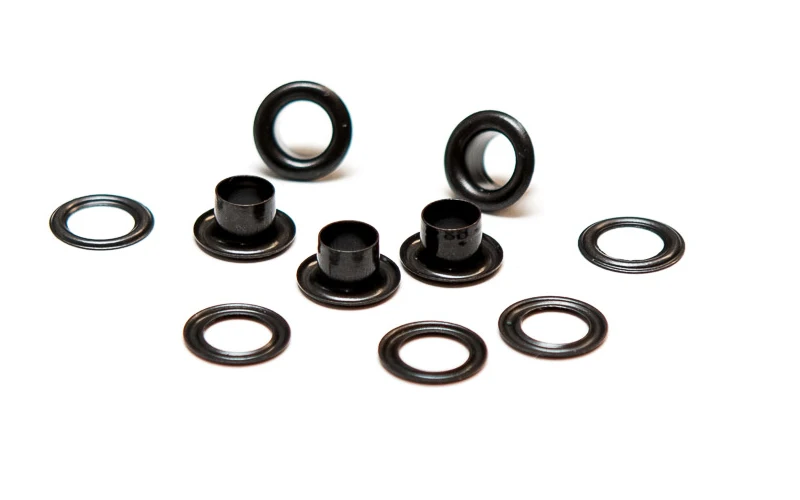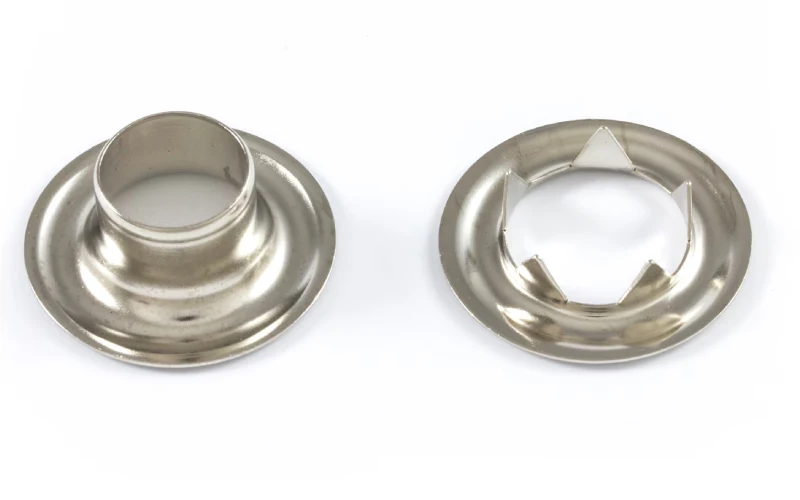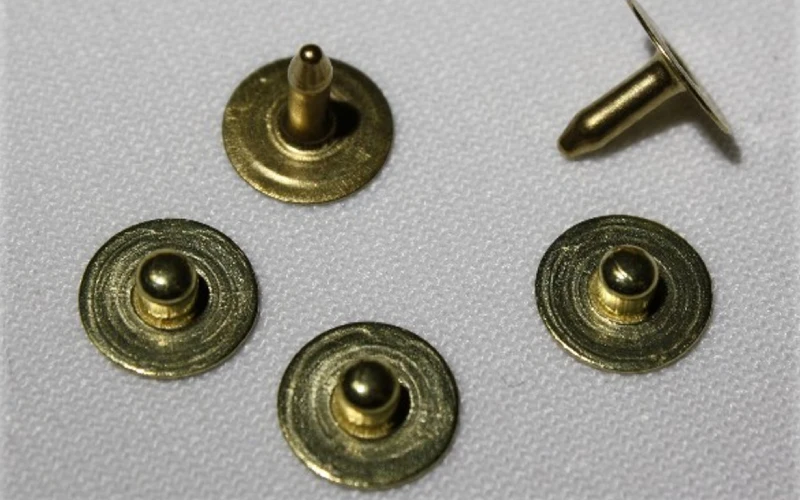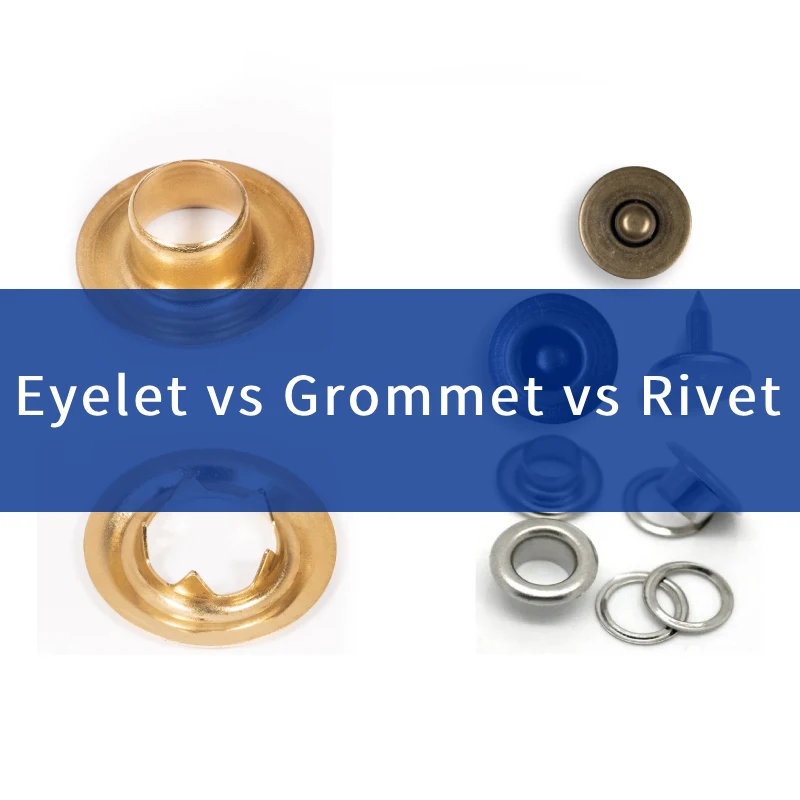Eyelet vs Grommet vs Rivet: Key Differences
When it comes to fasteners, eyelets, grommets, and rivets are three of the most commonly used options in various industries. While they may seem similar at first glance, they each have unique characteristics, applications, and installation methods. Understanding these differences can help you make an informed decision when choosing which fastener best suits your needs.
What Are Eyelets?

Eyelets are small, ring-like fasteners made of metal or plastic, designed to reinforce and protect holes in fabric, leather, or other materials. Typically, they consist of two main parts: a circular ring (also known as the eye) and a flange (the collar that holds the eyelet in place). Once inserted into a hole, the flange is crimped or flattened to secure the eyelet, helping to prevent the material from fraying and providing added strength to the area.
In addition to their functional role, eyelets are often used for decorative purposes, such as in clothing, accessories, and crafts. They can be found in a variety of colors and finishes, allowing for customization to suit different design needs.
Common Materials:
- Brass: Known for its durability and corrosion resistance.
- Stainless Steel: Strong and resistant to rust, making it ideal for outdoor and industrial applications.
- Aluminum: Lightweight and cost-effective, often used in applications where weight is a concern.
- Plastic: Common in fashion and lightweight applications, offering a variety of colors and finishes.
Common Applications:
- Clothing: Used in shoes (for laces), corsets, belts, and jackets to reinforce eyelets where laces or cords are threaded.
- Curtains: Reinforcing holes where curtain hooks or rods are inserted, allowing the fabric to hang smoothly.
- Tents and Tarps: Strengthening holes where ropes or cords are attached, making it easier to secure the fabric to poles or stakes.
- Crafts and DIY: In leatherworking, jewelry making, and other creative projects to add functional or aesthetic details.
What Are Grommets?

Grommets are similar to eyelets in that they are used to reinforce holes in materials, but they are typically larger and designed for more heavy-duty applications. Grommets are often composed of two separate parts— a top and bottom piece— which are crimped or pressed together to secure the grommet in place. This structure makes grommets more durable and resistant to wear and tear than eyelets, especially under stress.
Grommets are particularly useful in situations where the material is exposed to a lot of tension or movement, as they help distribute the stress more evenly across the hole.
Common Materials:
- Brass: Strong and resistant to corrosion, commonly used for both decorative and functional purposes.
- Copper: Often used in applications where both durability and an attractive finish are needed.
- Stainless Steel: Highly resistant to rust and oxidation, ideal for outdoor or industrial environments.
- Nickel-plated: Often used for decorative and functional purposes, offering a shiny, polished appearance.
Common Applications:
- Industrial Uses: Grommets are widely used to reinforce holes in cables, hoses, and electrical wiring. They provide protection from abrasion and prevent damage to the wires or materials being passed through them.
- Tarps and Outdoor Gear: Essential in securing ropes or cords to outdoor fabrics, such as tarps, tents, and sails. The grommet allows for easy attachment and removal while preventing the fabric from tearing.
- Luggage and Bags: Often used in luggage or bags for securing straps or handles, as they provide strength to prevent wear and tear where the straps meet the fabric.
- Automotive and Aerospace: Used in vehicles and aircraft to provide reinforcement in materials exposed to harsh conditions, such as extreme temperatures or mechanical stress.
What Are Rivets?

Rivets are a permanent fastening solution that consists of a cylindrical body and a mandrel (a pin-like component). Rivets are typically used to fasten two or more materials together by inserting the mandrel through a hole in the materials. Once inserted, the mandrel is deformed or “set” to create a strong, permanent bond that holds the rivet in place. This process makes rivets one of the most durable fastening solutions, especially for heavy-duty applications where other fasteners might not provide sufficient strength.
Rivets are often used in metalworking, but they can also be found in other industries requiring a secure, permanent joint. Unlike eyelets and grommets, rivets are not designed to be removed, making them ideal for applications where a lasting bond is needed.
Common Materials:
- Aluminum: Lightweight and corrosion-resistant, ideal for applications where weight and resistance to rust are important.
- Steel: Strong and durable, commonly used in construction, automotive, and industrial applications.
- Copper: Provides excellent electrical conductivity, often used in electrical or electronic applications.
- Stainless Steel: Known for its strength, corrosion resistance, and longevity, it is commonly used in marine and aerospace applications.
Common Applications:
- Automotive: Rivets are used extensively in car manufacturing to secure metal parts together, such as in the construction of car frames, panels, and components.
- Aerospace: In aircraft construction, rivets are used to join parts like fuselages, wings, and control surfaces, providing a permanent, strong connection that can withstand harsh conditions.
- Furniture: Rivets are often used in the construction of furniture, particularly in fastening leather or metal upholstery, where a durable and secure fastener is needed.
- Construction: Rivets are used to join structural components in buildings and bridges, offering a strong, long-lasting connection.
Eyelet vs Grommet: Key Differences
Material Comparison
While eyelets are primarily used in lightweight fabrics and are often made from brass, plastic, or aluminum, grommets are typically designed for tougher, more durable materials. Grommets can be made from similar materials as eyelets, but they are usually thicker and more substantial.
Durability and Strength
Grommets tend to offer superior durability and strength compared to eyelets, making them more suitable for heavy-duty applications such as outdoor gear, tents, and machinery. Eyelets, on the other hand, are generally better suited for applications where light reinforcement is needed, such as clothing or curtains.
Eyelet vs Rivet: Key Differences
Ease of Installation
Installing eyelets is typically easier than installing rivets. Eyelets can be set using simple hand tools or an eyelet press machine. Rivets, however, require specialized tools and are more challenging to install, particularly for large-scale or industrial projects.
Cost Comparison
Generally, eyelets are more affordable than rivets, mainly due to the materials and simpler installation process. Grommets tend to fall in between eyelets and rivets in terms of cost, making them a middle-ground choice for various applications.
Grommet vs Rivet: Key Differences
Choosing Between Grommets and Rivets
When deciding between grommets and rivets, it is important to consider the intended application. Grommets are typically preferred for reinforcing holes in fabric or flexible materials, while rivets are ideal for creating strong, permanent bonds in metal or heavy-duty materials.
Factors to Consider When Choosing Eyelets, Grommets, or Rivets
Material Type and Thickness
The type and thickness of the material you’re working with will play a major role in your decision. For lighter materials like cotton or polyester, eyelets or grommets may suffice. For tougher materials like metal or thick leather, rivets will provide the best hold.
Aesthetic and Functional Needs
If your project requires a decorative touch, eyelets might be the best choice. However, if you need something functional and sturdy, grommets or rivets should be your go-to fasteners.
How to Install Eyelets, Grommets, and Rivets
Tools Needed for Installation
- Eyelets: Hand tools or an eyelet press.
- Grommets: Grommet setters or an industrial machine.
- Rivets: Rivet gun or hammer and anvil for manual installation.
Pros and Cons of Eyelets, Grommets, and Rivets
| Type | Pros | Cons |
|---|---|---|
| Eyelets | – Cost-effective – Easy to install – Ideal for lightweight materials | – Less durable than grommets and rivets – Limited use in heavy-duty applications |
| Grommets | – Durable and strong – Versatile, with multiple material options | – Requires more tools for installation – More expensive than eyelets |
| Rivets | – Extremely durable – Best for metal and heavy-duty materials | – Difficult to install without specialized tools – More expensive than both eyelets and grommets |
FAQs
- What is the difference between an eyelet and a grommet? Eyelets are smaller, lighter, and easier to install, while grommets are larger, stronger, and more durable for industrial applications.
- Can eyelets be used for heavy-duty projects? While eyelets work for most lightweight applications, grommets or rivets should be used for heavy-duty tasks.
- Which fastener is best for clothing? Eyelets are commonly used in clothing, especially for laces, corsets, and decorative elements.
- Are rivets stronger than grommets? Yes, rivets are generally stronger than grommets and are better suited for metalworking and other heavy-duty applications.
- How do I install eyelets, grommets, or rivets? Eyelets and grommets are typically installed with hand tools or presses, while rivets require a rivet gun or hammer and anvil for installation.
- What is the best fastener for outdoor gear? Grommets are ideal for outdoor gear as they provide durability and resistance to wear and tear.
Conclusion
In conclusion, choosing between eyelets, grommets, and rivets depends largely on your material, project requirements, and budget. Eyelets are ideal for lightweight applications, grommets provide a durable solution for industrial needs, and rivets are perfect for heavy-duty tasks where strength is paramount. Consider these factors carefully to select the best fastener for your next project.

